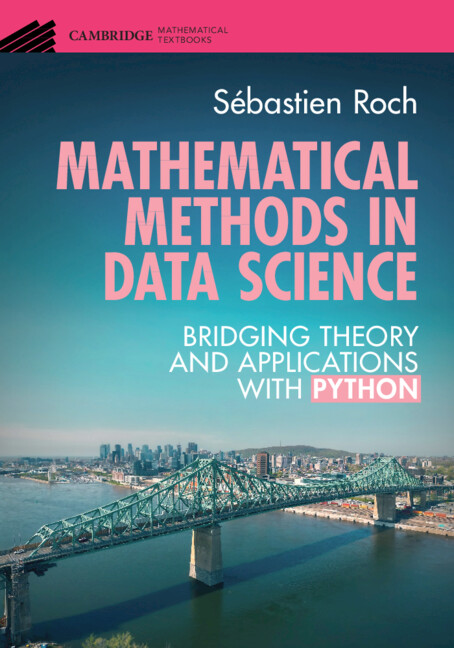MATHEMATICAL METHODS in DATA SCIENCE#
Author: Sebastien Roch, Department of Mathematics, University of Wisconsin-Madison
Full title: Mathematical Methods in Data Science: Bridging Theory and Applications with Python

Print copy: A print version of this textbook has been published by Cambridge University Press. It is available to order here. This online version will remain available and maintained. Additional resources can be found on the publisher’s website. See here for a list of typos. The book is based on Jupyter notebooks that were developed for MATH 535: Mathematical Methods in Data Science, a one-semester advanced undergraduate and master’s level course offered at UW-Madison. The online version was generated using Jupyter Book. See here for a collection of other such books.
Description: This textbook on the mathematics of data and AI has several intended audiences:
For students majoring in math or other quantitative fields like physics, economics, engineering, etc.: it is meant as an invitation to data science and AI from a rigorous mathematical perspective.
For mathematically-inclined students in data science related fields (at the undergraduate or graduate level): it can serve as a mathematical companion to machine learning, AI, and statistics courses.
Content-wise it is a second course in multivariable calculus, linear algebra, and probability motivated by and illustrated on data science applications. As such, the reader is expected to be familiar with the basics of those areas, as well as to have been exposed to proofs – but no knowledge of data science is assumed. Moreover, while the emphasis is on the mathematical concepts and methods, coding is used throughout. Basic familiarity with Python will suffice. The book provides an introduction to some specialized packages, especially Numpy, NetworkX, and PyTorch.
- 1. Introduction: a first data science problem
- 2. Least squares: geometric, algebraic, and numerical aspects
- 3. Optimization theory and algorithms
- 4. Singular value decomposition
- 5. Spectral graph theory
- 6. Probabilistic models: from simple to complex
- 7. Random walks on graphs and Markov chains
- 8. Neural networks, backpropagation and stochastic gradient descent
Important
To run the code in this book, you need to import the following librairies.
import numpy as np
from numpy import linalg as LA
import matplotlib.pyplot as plt
import pandas as pd
import networkx as nx
import torch
import mmids
The file mmids.py is here. All datasets can be downloaded on the GitHub page of the notes.
Jupyter notebooks containing just the code are provided at the end of each chapter. Running them in Google Colaboratory is recommended. The notebooks are also available in slideshow format. The slideshows were created using Jupyter; hence, instructors can create their own tailored version directly from the notebooks.
Note
If you find typos (in the online or print version), please open an issue on GitHub by using the provided button in the top right menu.
Supplementary materials: This online version also contains materials that supplement what can be found in the print book. Specifically, at the end of each chapter, one will find an Online Supplementary Materials section with:
Just The Code: a Jupyter notebook and slideshow with all the code from the chapter
Self-Assessement Quizzes: expanded, interactive self-assessment quizzes for each section
Auto-Quizzes: Jupyter notebooks featuring random quizzes with automatically generated answers
Solutions to Warm-Up Worksheets: solutions to all odd-numbered warm-up exercises
Additional Sections: additional content, typically at a somewhat more advanced level than the published book (e.g., proofs of more advanced results not required in the main text)
Image credit: Sidebar logo made with Midjourney
